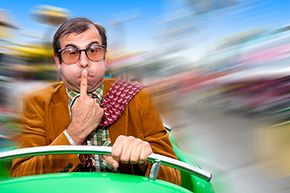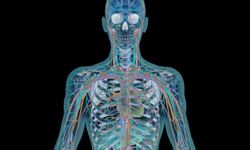Put forth by Thomas Stoffregen, a University of Minnesota professor of kinesiology and director of its Affordance Perception-Action Laboratory, the postural stability theory, or sway theory posits that motion sickness has nothing to do with the inner ear. Instead, it's linked to our body's natural swaying and equilibrium.
Every person's body sways, or moves, to some degree when he or she is standing. It's impossible for anyone to remain perfectly motionless. Many of us don't realize we're swaying a bit, though, as the motion is generally just an inch or two in each direction. In addition, we've all learned how to maintain our balance — say, by pushing back with our toes if we're pitching forward a bit, or with our heels if we're moving backward.
Now imaging putting your slightly swaying body on a ship or amusement park ride. You can't stabilize your body using the methods you've used all of your life — methods that normally work. That dissonance, that instability, is what causes motion sickness, says Stoffregen. So rather than motion sickness coming from conflicts among your body's motion sensors (eyes, inner ear, sensory receptors), it's occurring because you can't control your body's postural motion [sources: Beck, Stoffregen and Smart, Jr.].
Stoffregen also applies his theory to the fact that women are more prone to motion sickness than men. He notes males and females have similar bodies and swaying patterns before puberty. But once they mature sexually, their bodies become quite different, with women carrying more weight in their hips and men packing it in their chests. This difference in weight distribution makes them sway differently, with women swaying more slowly but farther. For women, that means an increased susceptibility to motion sickness. Stoffregen also claims a woman's tendency towards motion sickness can change along with her menstrual cycle. And with pregnancy. Pregnant women are at risk for motion sickness; Stoffregen says that's because pregnant women who suffered from morning sickness sway more [source: Smith].
Stoffregen published a study on the sway theory in 1998. For a long time, the idea was ignored but The New York Times reported in 2015 it is now gaining "grudging recognition."
It's unfortunate that so many of us succumb to motion sickness. But there are plenty of tricks for preventing and treating it. On the prevention side, one of the more common means is to take some kind of anti-motion sickness medication. Over-the-counter antihistamine pills (like Dramamine) are popular, as they make you drowsy which, in turn, makes you move less. The less you move, the better you feel.
You could also try scopolamine patches (brand name Transderm Scop); they can help by calming your inner ear's nerve activity. With any motion-sickness medication, the key is to take it well ahead of the time you travel. If you're popping pills when you start to feel queasy, it may be too late, as it's difficult to stop motion sickness once it's in, um, motion.
The best way to prevent illness if you're in a car is to be the driver, because then you can anticipate how the car is going to move, which enables your body to prepare for, say, a sudden, sharp curve to the right. If you can't be the driver, sit in the front seat, which also enables you to see looming movement changes. No matter what, don't sit in a seat that faces backward — because you need to see what's coming (rather than behind you) to feel better.
Also, don't read books, tap on your laptop or text on your phone in a car. The swaying words on the page or screen are sure to make you ill. It's also wise to eat something small before you travel so your stomach isn't empty. But no heavy meals, spicy or fatty foods or alcohol. Some people swear that downing gingery foods or drinks, or wearing an acupressure bracelet helps, although those measures haven't been scientifically proven effective. Finally keep your travel space well-ventilated and free of strong odors.
What if you forget to take your medicine, or can't resist poring over the latest copy of US Weekly, then suddenly start feeling ill? First, get some fresh air. Lying down might also help. If you can't do that, try to keep your head still. If you have access to food and drink, nibble on dry soda crackers or sip on a clear, fizzy drink (like ginger ale).
Another idea, especially if your motion sickness is on the mild side, is to chew gum. Or, actually, chew anything. It's the chewing action that helps, not the substance itself. Interestingly, motion sickness is rather suggestible. So if you see someone else becoming ill, look away. If a child appears to be getting sick, distraction often works.
Mind-body techniques, such as cognitive-behavioral therapy, biofeedback training and relaxation, and deep breathing can teach people who suffer from motion sickness how to avoid the condition or cope with it better [source: University of Maryland Medical Center].




